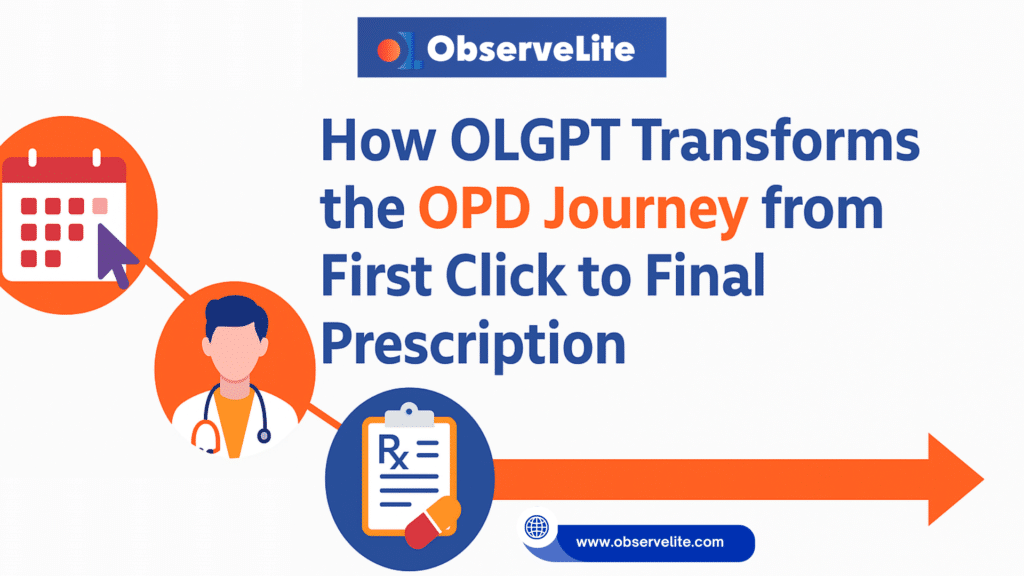If you have ever waited 30 minutes just to confirm your OPD appointment—or if you’re a doctor still typing notes during a 5-minute consultation—you know something is broken in outpatient care.
Long queues. Lost paperwork. Repetitive questions. Incomplete EMRs.
These aren’t just annoyances—they’re roadblocks to better outcomes, faster service, and smoother hospital operations.
Despite digitization efforts, most OPD workflows today are still:
- Dependent on call centers
- Burdened by manual data entry
- Disconnected between departments
- Stretched thin on staff productivity
This is where the promise of AI in outpatient care becomes real—not theoretical.
OLGPT is built to solve exactly these challenges.
It’s not just another tech layer—it’s a generative AI solution that understands clinical context, patient behavior, and hospital bottlenecks.
From the first appointment click to the final prescription, OLGPT transforms the outpatient journey by minimizing friction for staff and patients while ensuring clinical decisions are supported every step of the way. Here’s exactly how it works—and why it matters.
The Traditional OPD Workflow: A High-Touch, Low-Tech Burden
In a typical OPD setup:
- Patients book appointments via website, mobile app, or call centers.
- Nurses manually fill out assessment forms at the time of visit.
- Doctors consult and manually document findings.
- Prescriptions are written by hand or into EMR—often incomplete.
This linear model is functional but flawed:
- Call center dependency adds overhead.
- Manual data entry leads to errors or lost insights.
- Doctors waste time on documentation instead of patients.
- EMR adoption remains low.
Reimagining OPD with AI—OLGPT: An AI-Powered Patient Journey
OLGPT doesn’t patch the process—it reimagines it using AI-native automation, NLP, and clinical intelligence. Here’s how the OPD experience evolves at each stage:
✅ Step 1: Appointment Booking + Pre-Visit Query Resolution
What Happens Now: Patients book via call centers, often with long wait times and inconsistent information capture.
With OLGPT:
- A GenAI chatbot handles 24/7 appointment scheduling and patient queries.
- Patients can record voice notes or upload reports, which OLGPT transcribes, structures, and stores securely.
- Accurate medical details are captured before the visit—no need for repetitive explanations at the hospital.
Impact:
- Reduced load on call centers
- Faster onboarding
- Better-informed medical teams at arrival
✅ Step 2: AI-Assisted Nurse Triage and Initial Assessment
What Happens Now: Nurses manually fill intake forms with limited time for detailed history.
With OLGPT:
- OLGPT provides a summarized medical history, derived from patient-uploaded content or previous records.
- Nurses spend more time with patients and less on forms.
- Data entry becomes a validation process, not a manual task.
Impact:
- Reduced documentation burden
- Improved efficiency
- Optimized manpower utilization
✅ Step 3: Doctor Consultation with Structured EMR Insights
What Happens Now: Doctors listen, take notes, fill EMRs manually, or skip them due to time pressure.
With OLGPT:
- Doctors receive a structured, clinical history inside the EMR.
- Real-time consultation is supported by AI-assisted prompts, like previous diagnoses, test patterns, and flagged symptoms.
- Auto-suggestions for test orders, follow-ups, and treatment plans are generated by OLGPT.
Impact:
- Higher conversion from visit to treatment
- Fewer missed diagnoses
- Increased revenue retention and clinical compliance
✅ Step 4: AI-Generated Summaries and Prescriptions
What Happens Now:
Prescriptions are typed manually—often rushed, error-prone, or missing key details. Patients may leave without clear next steps.
With OLGPT:
- During the consultation, OLGPT listen for clinical cues, captures relevant findings, and compiles a structured prescription draft in real time.
- Once reviewed, it’s sent directly to the EMR and made accessible to the patient through their preferred channel.
- OLGPT also initiates automated follow-up triggers—whether it’s a refill reminder, a lab recheck, or a return visit.
Impact:
- Patients stay on track with treatment plans
- EMRs stay complete and compliant
- Doctors regain time to focus on care—not formatting
From Fragmented to Fluid: A Unified OPD Pipeline
OLGPT does more than digitize—it intelligently connects the dots between administrative steps, clinical logic, and patient interaction. Here’s what that means in practice:
| Stage | Traditional OPD | AI-OLGPT Enhanced OPD |
| Appointment Booking | Call center/manual | 24×7 AI chatbot with voice recognition |
| Nurse Intake | Manual form filling | AI-summarized history input |
| Doctor Consultation | Note-taking on paper | Smart EMR overlay with AI prompts |
| Prescription | Manual write-up | Auto-generated summaries and reminders |
| EMR Usage | Low adoption | Seamless integration and updates |
Benefits for Every Stakeholder
For Hospitals:
- Reduced admin load.
- Optimized manpower
- EMR-centric data flow
- Improved conversion rates
For Doctors:
- Less time typing, more time diagnosing
- Decision support during consultation
- Fewer errors in documentation
For Patients:
- Shorter wait times
- Better information continuity
- Clear prescriptions and follow-ups
Business Value: Why It’s More Than Just Automation
This is not just workflow automation—it’s revenue intelligence and clinical optimization:
- Reduced Revenue Leakage: Missed charges due to poor documentation are eliminated.
- Regulatory Compliance: All data is audit-ready and PDP-compliant.
- Real-Time Feedback Loop: Every patient touchpoint generates structured, reusable insights.
Built for Clinics, Scaled for Hospitals
OLGPT can be deployed in:
- Small clinics needing structured consultation workflows
- Mid-size hospitals looking to eliminate call center overhead
- Large institutions aiming for EMR-led outpatient care at scale
It supports on-prem, cloud, and hybrid deployments, making it versatile and compliant with regional data regulations.
Final Thoughts: From First Click to Final Prescription—Seamlessly
The OPD model is broken—but OLGPT offers a better way.
A way that puts clinical intelligence, automation, and patient experience at the heart of outpatient care.
This isn’t about replacing doctors.
It’s about giving them superpowers—and giving patients the experience they deserve.
Ready to transform your outpatient operations?


